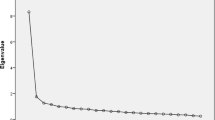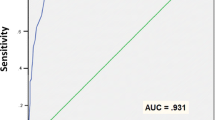Abstract
A brief self-report scale is described that assesses propensity for male abusiveness of a female partner in intimate relationships. The scale items are nonreactive, containing no explicit reference to abusive behavior. The scale has good psychometric properties, with a Cronbach's alpha of .91 and three distinct factors. The scale was validated against reports of abuse victimization by mens'’ female partners using the Psychological Maltreatment of Women Inventory (Tolman, 1988). The scale correlated .51 with women's reports of male Domination/Isolation tactics and .47 with Emotional Abuse scale scores. A discriminant function for high vs. low abusiveness indicated that the Propensity for Abusiveness Scale (PAS) correctly classified 82.2% of men into high (one standard deviation above the mean) or low abusiveness (one standard deviation below) abusiveness. Social desirability corrections do not significantly alter the pattern of correlations of the PAS with criterion variables. A cross-validation of the scale supported the initial results. The scale also correlates significantly with physical abuse.
Similar content being viewed by others
References
Arias, I., and Beach, S. R. (1987). Validity of self-reports of marital violence.J. Fam. Viol. 2(2): 139–150.
Bartholomew, K., and Horowitz, L. M. (1991). Attachment styles among young adults: A test of a four category model.J. Personal. Social Psychol. 61(2): 226–244.
Briere, J., and Runtz, M. (1989). The Trauma Symptom Checklist (TSC-33): Early data on a new scale.J. Interpers. Viol. 4(2): 151–163.
Browning, J. J., and Dutton, D. G. (1986). Assessment of wife assault with the Conflict Tactics Scale: Using couple data to quantify the differential reporting effect.J. Marr. Fam. 48: 375–379.
Check, J., and Malamuth, N. (1985).The Hostility Toward Women Scale, Paper presented at the International Society for Research on Aggression, Victoria, B.C.
Choca, J. P., Shanley, L. A., and Van Denburg, E. (1992).Interpretative Guide to the Millon Clinical Multiaxial Inventory, APA Press, Washington, DC.
Collins, N. L., and Read, S. J. (1990). Adult attachment, working models and relationship quality in dating couples.J. Personal. Social Psychology 58: 644–663.
Crowne, D. P., and Marlowe, D. (1960). A new scale of social desirability independent of psychopathology.J. Consult. Psychol. 24: 349–354.
Dutton, D. G. (1995a). Behavioral and affective correlates of Borderline Personality Organization in wife assaulters.Int. J. Law Psychiatry 17(3): 265–279.
Dutton, D. G. (1995b). Trauma symptoms and PTSD profiles in perpetrators of intimate abuse.J. Traum. Stress 8(2): 299–315.
Dutton, D. G. (1995c). The origin and structure of the abusive personality.J. Personal. Dis. 8(3): 181–191.
Dutton, D. G. (1993). William Head Project: Research Report #1, Correction Service of Canada, Ottawa.
Dutton, D. G., and Hemphill, K. J. (1992). Patterns of socially desirable responding among perpetrators and victims of wife assault.Viol. Vict. 7(1): 29–40.
Dutton, D. G., Starzomski, A., and Ryan, L. (1994).Antecedents of abusive personality and abusive behavior in wife assaulters, Unpublished Manuscript (under review). Department of Psychology, University of British Columbia.
Dutton, D. G., and Starzomski, A. J. (1995a). Psychological differences in court vs. self referred wife assaulters.Crim. Just. Behav. 21(2): 203–222.
Dutton, D. G, and Starzomski, A. J. (1995b). Borderline personality in perpetrators of psychological and physical abuse.Viol. Vict. In press.
Dutton, D. G., Saunders, K., Starzomski, A., and Bartholomew, K. (1995). Intimacy-anger and insecure attachment as precursors of abuse in intimate relationships.J. Appl. Social Psychol. In press.
Gerslma, C., Emmelkamp, P. M. G., and Arrindell, W. A. (1990). Anxiety, depression and perception of early parenting: A meta-analysis.Clin. Psychol. Rev. 10: 251–277.
Griffin, D., and Bartholomew, K. (1992).Testing a Two Dimensional Model of Adult Attachment: A Latent Variable Approach, Department of Psychology, University of Waterloo.
Gunderson, J. G. (1984).Borderline Personality Disorder, American Psychiatric Press, Inc., Washington, DC.
Hazan, C., and Shaver, P. R. (1987). Conceptualizing romantic love as an attachment process.J. Personal Social Psychol. 52: 511–524.
Marshall, L. (1992). Development of the severity of violence against women scales.J. Fam. Viol. 7(2): 103–121.
Millon, T. (1981).Disorders of Personality, DSM-III: Axis II, Wiley, New York.
Millon, T. (1987).Manual for the Manual for the Millon Clinical Multiaxial Inventory-II, National Computer Systems, Minneapolis, Minn.
Oldham, J., Clarkin, J., Appelbaum, A., Carr, A., Kernberg, P., Lotterman, A., and Haas, G. (1985). A self-report instrument for Borderline Personality Organization. In McGlashan, T. H. (ed.),The Borderline: Current Empirical Research, The Progress in Psychiatry Series, American Psychiatric Press, Washington, DC., pp. 1–18.
Perris, C., Jacobsson, L., Lindstrom, H., von Knorring, L., and Penis, H. (1980). Development of a new inventory for assessing memories of parental rearing behavior.Acta Psychiat. Scand. 61: 265–274.
Paulhus, D. (1984). Two-component models of socially desirable responding.J. Personal. Social Psychol. 46: 598–609.
Ross, M. W., Campbell, R. L., and Clatyer, J. R. (1982). New inventory of measurement of parental rearing patterns: An English form of the EMBU.Acta Psychiat. Scand. 66: 499–507.
Saunders, D. (1991). Procedures for adjusting self-reports of violence for social desirability bias.J. Interpers. Viol. 6(3): 336–344.
Siegel, J. M. (1986). The multidimensional anger inventory.J. Personal. Social Psychol. 51(1): 191–200.
Straus, M. A. (1979). Measuring family conflict and violence: The conflict tactics scale.J. Marr. Fam. 41: 75–88.
Tolman, R. M. (1989). The development of a measure of psychological maltreatment of women by their male partners.Viol. Vict. 4(3): 159–177.
Author information
Authors and Affiliations
Rights and permissions
About this article
Cite this article
Dutton, D.G. A scale for measuring propensity for abusiveness. J Fam Viol 10, 203–221 (1995). https://doi.org/10.1007/BF02110600
Issue Date:
DOI: https://doi.org/10.1007/BF02110600




